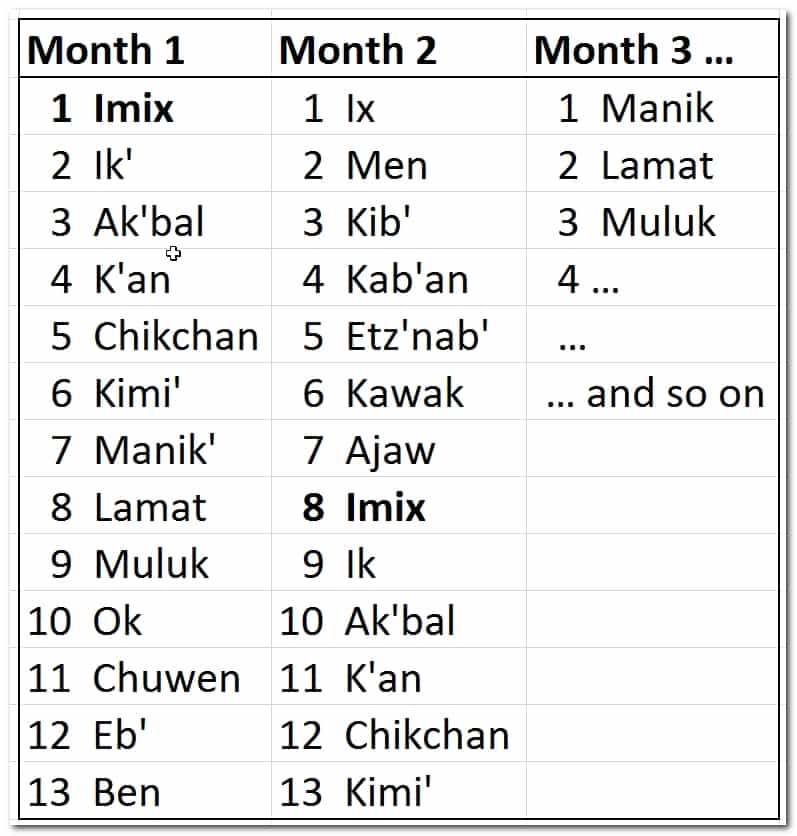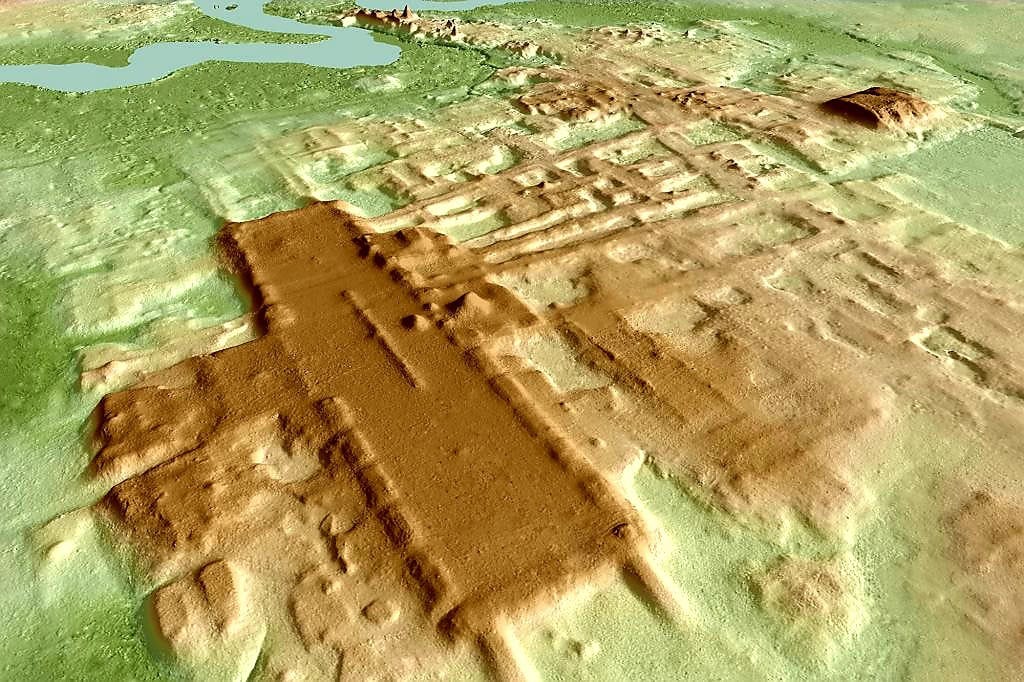The Maya Calendar – Part 3 -Tzolkin, the Sacred Calendar
This post “The Maya Calendar” is an excerpt of the second edition of my book “The Maya Sites – Hidden Treasures of the Rain Forest”, a travel guide to the most important Maya sites on the Yucatán peninsula – in México and Guatemala. The second edition will be published as print and ebook in spring 2018.
I split this article into seven parts:
- The Maya calendar – Part 1 – Introduction
- The Maya calendar – Part 2 – Haab, the Solar Year
- The Maya calendar – Part 3 – Tzolkin, the Sacred Calendar <<– You are here
- The Maya calendar – Part 4 – The Calendar Round
- The Maya calendar – Part 5 – The Long Count
- The Maya calendar – Part 6 – The Numbers and the Vigesimal System
- The Maya calendar – Part 7 – Dates and Numbers in the Inscriptions
The Tzolkin Calendar
In addition to the Haab calendar, the Maya used a second calendar, which is known as Tzolkin calendar. Tzolkin or Tzolk’in means “count of days”.
The Tzolkin consists of two different cycles that were used in combination to designate a single day. For this purpose, two lists were linked together. On the one hand, these were the numbers 1 to 13 and on the other hand, the 20 day names.
13 times 20 then results in the length of the Tzolkin year thus determined by 260 days. After that, another year started.
The Tzolkin calendar is also given the name “Sacred Calendar”. The reason for this is that it is the calendar that is still used today for ceremonial or prophetic purposes in some areas of the Maya region, especially by ethnic groups in the highland region.
Looking closer to the Tzolkin, a reference to agriculture can be seen, similar to the Haab. Some researchers assume that the Tzolkin is a calendar that has developed independently of the Haab calendar. Originally this calendar was used to determine the exact days for various activities in maize cultivation.
As mentioned above, the research assumes that the entire calendar system of the Maya was mobile and not anchored as ours that is fixed and synchronized with the actual position of the sun. How this can be reconciled with the purpose of the calendar as a tool for growing corn is puzzling.
The names and order of the day names are shown below: Imix, Ik, Akbal, Kan, Chicchán, Cimí, Manik, Lamat, Muluc, Oc, Chuen, Eb, Ben, Ix, Men, Cib, Cabán, Etznab, Cauac, Ahau.
Nummer
Monat
Übersetzung
Cholan
1
Imix
Water or water lilly
Ha’
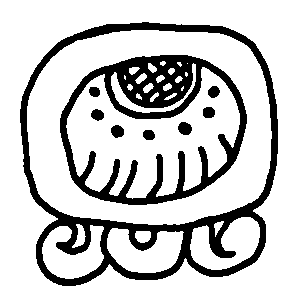
Imix’ , the first day of the 20 day cycle is represened by a sign showing the symbol of the water lily. The sign itself reads Ha’, what means water in ancient Maya. The water lily is considered by the Maya as a symbol of the hidden. Other depictions show a reptiloid monster known as the “water lily monster”. Maybe it is a crocodile.
2
Ik
Wind
Ik’

The T-shaped structure inside the symbol represents the wind. Ik ‘also serves as a symbol for the wind, life, air, breath and voice.
3
Akbal
Nacht
Ak’Ab’
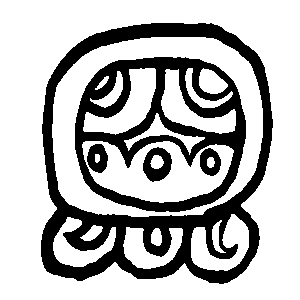
Night, darkness, dusk, snake. Inside the cartouche you can see the detail of a serpent body viewed from the side with the lower belly scales and an spine mark above.
4
Kan
Yellow
Ol

The word K’an can mean both yellow and ripe maize. The symbol in the center of the Tzolkin sign has two different readings in the inscriptions. Most widely it was used for waaj, what means “tamales” or oohl, what means as much as “maize dough”. It is assumed, that the Cholan word Ol means “in the middle of”, the heart, an opening or simply describes the ball used in ball game of the Maya.
5
Chikchan
Feathered Serpent
Chikchan ?

This day is represented by the depiction of a snake head. Chikchan could be a synonym for Kukulkan, the feathered serpent. Just the symbol itself reads Kaan in the inscriptions, meaning “snake”.
6
Cimi
Death
Cham

The symbol is similar to a percent sign. It means “death” On other Cimi symbols is a skull with the% sign on the cheek. In classic texts the symbol reads as Cham = Death or to die
7
Manik
Deer
chi
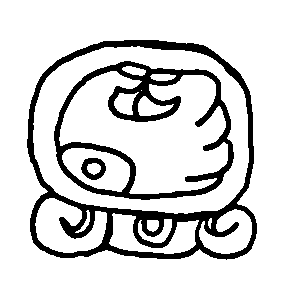
The back of a human hand. The inner symbol reads Chi, meaning “deer”
8
Lamat
Star
Ek’

Shows the symbol Ek ‘- star or Venus
9
Muluk
Water animals and water
?
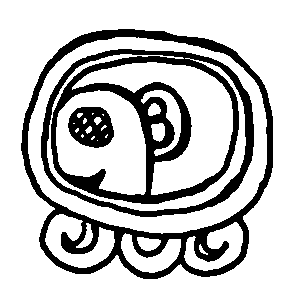
The sign Muluk stands for water and also aquatic animals.
10
Ok
Dog
Ok / Tz’i
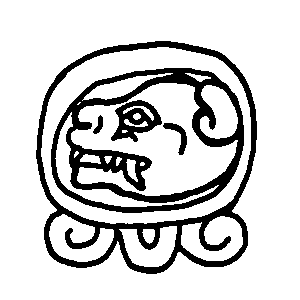
The symbol shows the head of a dog, it stands for friendship and loyalty.
11
Chuwen
Monkey
?

According to traditions of the Maya, the year of the Tzolkin calendar begins with 8 Chuen. It symbolizes a (roaring) monkey. Chuwen is also the title the scribes wear. In connection with Sak, the word is used as a title “Sak Chuwen”: brilliant, glorious or outstanding scribe
12
Eb
God of Death
?
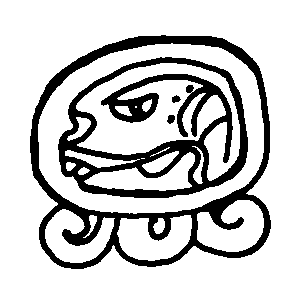
Shows a skull. On the back of the head is sometimes the sign of Kawak, the 19th Tzolkin symbol.
13
Ben
Throne
?

Shows the stylized side view of a throne.
14
Ix
Jaguar
Hix
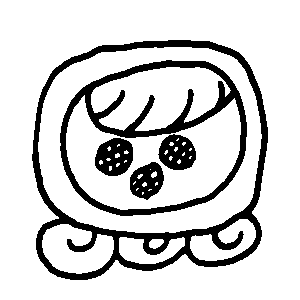
Is the sign for Jaguar, symbolized by the three dots. Hix also means motherhood and earth mother.
15
Men
Eagle
?
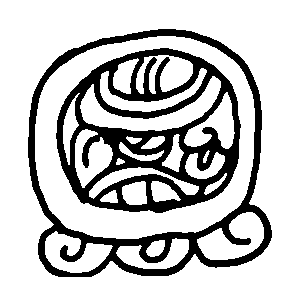
Shows the head of a bird, possibly an eagle.
16
Cib
Sea shell
?

The symbol shows a shell…
17
Kaban
Earth
Chab’

Kab’an symbolizes the earth. It also stands for knowledge and science. The sign Kab ‘in the center means earth.
18
Etznab
Flint Stone
?
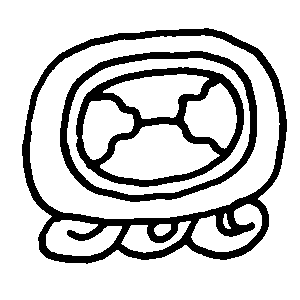
The symbol stylized shows the machined surface of an obsidian or flint blade
19
Kawak
Rain
?
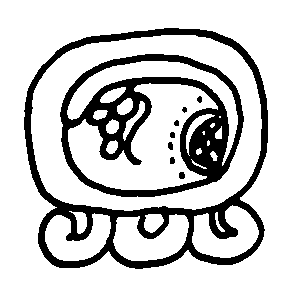
Kawak represents storm and rain. The central symbol means Tun = year or stone. It shows a grape-shaped rain symbol on the left and a symbol for a rainbow on the right.
20
Ahau
Lord
Ajaw
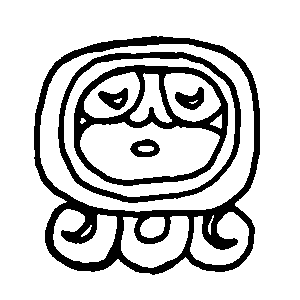
Ajaw means lord or king in the sense, a title for a ruler. It is also a symbol of the sun god.
To define a day, a number between 1 and 13 was combined with a day’s name. Then the number was increased by one and at the same time, the next day’s name was used.
So if one year started with 1 Imix, then 2 Ik followed the day after, then 3 Aakbal, then 4 kan, and so on.
When the 13 was reached, the numbers started all over again but continued with the names in the order above.
13 Ben was followed by 1 Ix, then 2 Men, until the 20th day with the name 7 Ahau was reached.
At this point, then the numbers were continued and the day names began again from the start point.
7 Ahau was followed by 8 Imix, then 9 Ik and so on.
Sounds complicated, but it is not. The following table shows how it works.
First, take a number and combine it with a day sign. Then increase the number by one and combine it with the next day’s sign.
Originally, the Tzolkin seems to have been anchored in the course of the year, which means that it always began on the same day in the year.
And indeed, in the highlands of Guatemala, it is still used today to determine the exact dates for maize cultivation.
However, anthropologists have also discovered other uses of the calendar, such as determining the length of pregnancies or simply astrological reference prophecy calendars.Anyway.
The Maya researchers agree that the Tzolkin was not anchored when used in inscriptions, but simply repeated after 260 days.
A big amount of recent archaeo-astronomical examinations of buildings of the classical Maya period have shown evidence, that these buildings were aligned in a way that corresponds to the 260 days of the Tzolkin calendar.
>>> Continue with: The Maya Calendar – Part 4 – The Calendar Round
